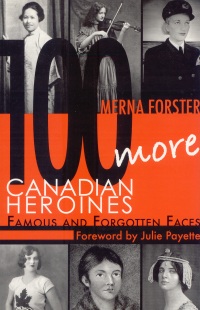| ________________
CM . . .
. Volume XIX Number 10. . . .November 9, 2012
excerpt:
Seven years in the making, historian Forster's 100 More Canadian Heroines is a welcome follow up to her acclaimed 100 Canadian Heroines (Vol. XI, No. 19, May 27, 2005). Most of the features of the earlier volume are carried over into this book; however, there are a few changes. This volume includes three subjects who were still living at the time of publication. In reality, Forster writes about 100 women, including two sets of sisters who are presented in joint entries, and one biography, that of B.C. pioneer Catherine Schubert, is penned by Emily Zheng, winner of the publisher's heroines essay contest for students. All entries, except for Zheng's, include footnotes to a wide array of published, unpublished and e resources if applicable. Most of the biographies are drawn from more than one source. In choosing figures to recognize and celebrate for their achievements, Forster adopts legal scholar Constance Backhouse's concept of heroine that "captures the lives of women who represent resistance, strength, courage, persistence, and fortitude" as they face oppression or other challenges - a definition that is inclusive of the experiences of a wide variety of women and does not require perfection. In fact, Forster includes some subjects, like Charlotte Whitton, the first female mayor in a major Canadian city, who made significant contributions while also holding racist views that are noted. As before, Forster's selections include women, like entrepreneur Elizabeth Arden and medical doctor Victoria Cheung, who were born in Canada but established their careers and reputations working abroad. About one quarter of the subjects were born abroad and either immigrated to Canada or made a historic first on present day Canadian territory. The concept of historic first appears to have governed many of the selections and is emphasized in the brief summary statement that follows the initial entry data for a biography: chapter title, name, inclusive dates when known, and summary statement. For example:
Bound for Uncharted Waters Some of the other firsts that are recognized include first European woman to own land in present day Ontario, first woman elected chief of a First Nation, first Jewish woman in New France, first Japanese woman immigrant to Canada, first Francophone female doctor in Quebec, first female colonel in the Canadian Army, first female game warden, first single woman to be granted a homestead in Ontario, first woman to operate a flying club, first female sea captain in North America, first female lawyer in the British Empire, first Chief Commissioner of the Girl Guides of Canada, first Canadian woman to gain international acclaim as a conductor, and first woman in Canada to receive a university degree in architecture. Entries are arranged alphabetically by surname and typically include one or two photographs or illustrations showing the person or rarely other family members or a scene from their historic period. Most entries are three to four pages in length and usually end with a brief quote by the biographee. Women from all parts of Canada are represented except for Nunavut and the Northwest Territories. Most of the women were active in Ontario, Quebec or British Columbia. This is not surprising given the large populations of these three provinces. Forster profiles many members of visible or ethnic or religious minorities, including nine members of First Nations communities, four Canadians of African descent, several Jews, one Sikh, one Muslim, one Doukhobor, a couple of Japanese Canadians, one Chinese-Canadian, one Caucasian who married a Chinese Canadian and was active in the Chinese community, one Icelandic Canadian and several Catholic nuns. An analysis by year of death shows that 22 died before 1899, 26 between 1900 -1950, 43 between 1951-1999, six between 2000-2011, with three still living as of 2011. The women profiled were active in many fields, and some made contributions in multiple fields of endeavour. Astronomy, athletics, business, community building, civil rights and abolition of slavery, conservation, ethnic pioneers, education including post secondary teaching, exploration, farming, film and performing arts, journalism, labour, law and politics, nursing and medicine, pioneer settlement, suffrage and other equal rights advocacy, religious life, temperance, tourism, and the visual arts are the main categories of accomplishment highlighted in the volume. Forster notes when a biography has been recognized by the Historic Sites and Monuments Board of Canada as a person of national historic significance, and tends to note recognition by provincial historic boards and commemoration of the subject on a postage stamp issued by Canada Post.
Forster's writing style is often informal and makes use of clichés. This will not be a concern to most of the target audience. Tighter editing is called for as several major and some minor errors appear in the text. Overall, the volume is attractively designed, inspirational and sadly, there is still a need to highlight the achievements of Canadian women. Why, for example, has hockey player and coach Hilda Ranscombe, 1913-1998, never been admitted to the Canadian Hockey Hall of Fame? Gender hierarchy persists in sports, and gender equality in general remains an elusive ideal in large swaths of Canadian society. The detailed footnotes and the selected bibliography that extends to ten pages will be valued by readers who want to find out more about the women profiled. Highly Recommended. Val Ken Lem is a librarian at Ryerson University in Toronto, ON.
To comment
on this title or this review, send mail to cm@umanitoba.ca.
Copyright © the Manitoba Library Association. Reproduction for personal
use is permitted only if this copyright notice is maintained. Any
other reproduction is prohibited without permission.
NEXT REVIEW |
TABLE OF CONTENTS FOR THIS ISSUE
- November 9, 2012.
AUTHORS |
TITLES |
MEDIA REVIEWS |
PROFILES |
BACK ISSUES |
SEARCH |
CMARCHIVE |
HOME |
